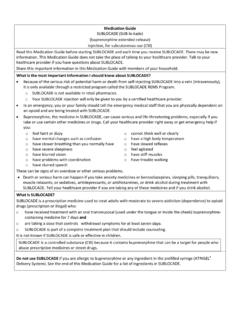Transcription of Prescribing Information | SUBLOCADE® (buprenorphine ...
1 HIGHLIGHTS OF Prescribing Information These highlights do not include all the Information needed to use SUBLOCADE safely and effectively. See full Prescribing Information for SUBLOCADE. SUBLOCADE (buprenorphine extended release) injection, for subcutaneous use CIII Initial Approval: 2002 INDICATIONS AND USAGE SUBLOCADE contains buprenorphine, a partial opioid agonist, and is indicated for the treatment of moderate to severe opioid use disorder in patients who have initiated treatment with a transmucosal buprenorphine containing product, followed by dose adjustment for a minimum of 7 days. (1) SUBLOCADE should be used as part of a complete treatment program that includes counseling and psychosocial support. (1) DOSAGE AND ADMINISTRATION Prescription use of this product is limited under the Drug Addiction Treatment Act.
2 ( ) SUBLOCADE should only be prepared and administered by a healthcare provider. ( ) SUBLOCADE is administered monthly only by subcutaneous injection in the abdominal region. ( ) The recommended dose of SUBLOCADE is two monthly initial doses of 300 mg followed by 100 mg monthly maintenance doses. ( ) Increasing the maintenance dose to 300 mg monthly may be considered for patients in which the benefits outweigh the risks . ( ) Examine the injection site for signs of infection or evidence of tampering or attempts to remove the depot. ( ) See Full Prescribing Information for administration instructions. ( ) DOSAGE FORMS AND STRENGTHS Injection: 100 mL and 300 mL provided in a prefilled syringe with a 19 Gauge 5/8 inch needle. (3) CONTRAINDICATIONS Hypersensitivity to buprenorphine or any other ingredients in SUBLOCADE.
3 (4) WARNINGS AND PRECAUTIONS Addiction, Abuse, and Misuse: Buprenorphine can be abused in a manner similar to other opioids. Monitor patients for conditions indicative of diversion or progression of opioid dependence and addictive behaviors. ( ) Respiratory Depression: Life threatening respiratory depression and death have occurred in association with buprenorphine. Warn patients of the potential danger of self administration of benzodiazepines or other CNS depressants while under treatment with SUBLOCADE. ( , ) Neonatal Opioid Withdrawal Syndrome: Neonatal opioid withdrawal syndrome (NOWS) is an expected and treatable outcome of prolonged use of opioids during pregnancy. ( ) Adrenal Insufficiency: If diagnosed, treat with physiologic replacement of corticosteroids, and wean patient off of the opioid. ( ) Risk of Opioid Withdrawal With Abrupt Discontinuation: If treatment with SUBLOCADE is discontinued, monitor patients for several months for withdrawal and treat appropriately.
4 ( ) Risk of Hepatitis, Hepatic Events: Monitor liver function tests prior to and during treatment. ( ) Risk of Withdrawal in Patients Dependent on Full Agonist Opioids: Verify that patient is clinically stable on transmucosal buprenorphine before injecting SUBLOCADE. ( ) Treatment of Emergent Acute Pain: Treat pain with a non opioid analgesic whenever possible. If opioid therapy is required, monitor patients closely because higher doses may be required for analgesic effect. ( ) ADVERSE REACTIONS Adverse reactions commonly associated with SUBLOCADE (in 5% of subjects) were constipation, headache, nausea, injection site pruritus, vomiting, increased hepatic enzymes, fatigue, and injection site pain. (6) To report SUSPECTED ADVERSE REACTIONS, contact Indivior Inc. at 1 877 782 6966 or FDA at 1 800 FDA 1088 or DRUG INTERACTIONS CYP3A4 Inhibitors and Inducers: Monitor patients starting or ending CYP3A4 inhibitors or inducers for potential over or under dosing.
5 (7) Serotonergic Drugs: If concomitant use is warranted, monitor for serotonin syndrome, particularly during treatment initiation, and during dose adjustment of the serotonergic drug. (7) USE IN SPECIFIC POPULATIONS Lactation: Buprenorphine passes into the mother s milk. ( ) Geriatric Patients: Monitor for sedation or respiratory depression. ( ) Moderate to Severe Hepatic Impairment: Not recommended. ( , ) See 17 for PATIENT COUNSELING Information and Medication Guide. Revised: 3/2018 WARNING: RISK OF SERIOUS HARM OR DEATH WITH INTRAVENOUS ADMINISTRATION; SUBLOCADE RISK evaluation AND mitigation strategy See full Prescribing Information for complete boxed warning. Serious harm or death could result if administered intravenously. ( ) SUBLOCADE is only available through a restricted program called the SUBLOCADE rems Program.
6 Healthcare settings and pharmacies that order and dispense SUBLOCADE must be certified in this program and comply with the rems requirements. ( ) FULL Prescribing Information : CONTENTS* WARNING: RISK OF SERIOUS HARM OR DEATH WITH INTRAVENOUS ADMINISTRATION; SUBLOCADE RISK evaluation AND mitigation strategy 1 INDICATIONS AND USAGE 2 DOSAGE AND ADMINISTRATION Drug Addiction Treatment Act Important Dosing and Administration Information Recommended Dosing Patient Selection Clinical Supervision Instructions for Use Limits on Distribution Removal of the Depot 3 DOSAGE FORMS AND STRENGTHS 4 CONTRAINDICATIONS 5 WARNINGS AND PRECAUTIONS Risk of Serious Harm or Death With Intravenous Administration SUBLOCADE Risk evaluation and mitigation strategy ( rems ) Program Addiction, Abuse, and Misuse Risk of Respiratory and Central Nervous System (CNS)
7 Depression Managing risks From Concomitant Use of Benzodiazepines or Other CNS Depressants With Buprenorphine Neonatal Opioid Withdrawal Syndrome Adrenal Insufficiency Risk of Opioid Withdrawal With Abrupt Discontinuation of SUBLOCADE Treatment Risk of Hepatitis, Hepatic Events Hypersensitivity Reactions Precipitation of Opioid Withdrawal in Patients Dependent on Full Agonist Opioids risks Associated With Treatment of Emergent Acute Pain Use in Opioid Na ve Patients Use in Patients With Impaired Hepatic Function Use in Patients at Risk for Arrhythmia Impairment of Ability to Drive or Operate Machinery Orthostatic Hypotension Elevation of Cerebrospinal Fluid Pressure Elevation of Intracholedochal Pressure Effects in Acute Abdominal Conditions Unintentional Pediatric Exposure 6 ADVERSE REACTIONS Clinical Trials Experience Postmarketing Experience 7 DRUG INTERACTIONS 8 USE IN SPECIFIC POPULATIONS Pregnancy Lactation Females and Males of Reproductive Potential Pediatric Use Geriatric Use Hepatic Impairment Renal Impairment 9
8 DRUG ABUSE AND DEPENDENCE Controlled Substance Abuse Dependence 10 OVERDOSAGE 11 DESCRIPTION 12 CLINICAL PHARMACOLOGY Mechanism of Action Pharmacodynamics Pharmacokinetics 13 NONCLINICAL TOXICOLOGY Carcinogenesis, Mutagenesis, Impairment of Fertility 14 CLINICAL STUDIES Study 13 0002, NCT02044094 Study 13 0001, NCT02357901 16 HOW SUPPLIED/STORAGE AND HANDLING 17 PATIENT COUNSELING Information * Sections or subsections omitted from the full Prescribing Information are not listed. 3 FULL Prescribing Information 1 INDICATIONS AND USAGE SUBLOCADE is indicated for the treatment of moderate to severe opioid use disorder in patients who have initiated treatment with a transmucosal buprenorphine containing product, followed by dose adjustment for a minimum of 7 days. SUBLOCADE should be used as part of a complete treatment plan that includes counseling and psychosocial support.
9 2 DOSAGE AND ADMINISTRATION Drug Addiction Treatment Act Under the Drug Addiction Treatment Act (DATA) codified at 21 823(g), prescription use of this product in the treatment of opioid dependence is limited to healthcare providers who meet certain qualifying requirements, and who have notified the Secretary of Health and Human Services (HHS) of their intent to prescribe this product for the treatment of opioid dependence and have been assigned a unique identification number that must be included on every prescription. Important Dosing and Administration Information FOR ABDOMINAL SUBCUTANEOUS INJECTION ONLY. DO NOT ADMINISTER SUBLOCADE INTRAVENOUSLY OR INTRAMUSCULARLY [see Warnings and Precautions ( ), Dosage and Administration ( )]. Only healthcare providers should prepare and administer SUBLOCADE. Administer SUBLOCADE monthly with a minimum of 26 days between doses.
10 Initiating treatment with SUBLOCADE as the first buprenorphine product has not been studied. Initiate SUBLOCADE treatment only following induction and dose adjustment with a transmucosal buprenorphine containing product [see Dosage and Administration ( )]. Administer each injection only using the syringe and safety needle included with the product [see Dosage and Administration ( )]. WARNING: RISK OF SERIOUS HARM OR DEATH WITH INTRAVENOUS ADMINISTRATION; SUBLOCADE RISK evaluation AND mitigation strategy Serious harm or death could result if administered intravenously. SUBLOCADE forms a solid mass upon contact with body fluids and may cause occlusion, local tissue damage, and thrombo embolic events, including life threatening pulmonary emboli, if administered intravenously. ( ) Because of the risk of serious harm or death that could result from intravenous self administration, SUBLOCADE is only available through a restricted program called the SUBLOCADE rems Program.





